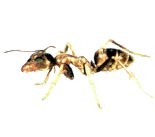 |
| Color: |
Dark brown to black; shiny |
| Legs: |
6 |
| Shape: |
Segmented; oval |
| Size: |
1/16-1/4″ |
| Antennae: |
Yes |
| Region: |
AL,AR,CA,FL,GA,IL,LA,MD,MO,MS,NC,NJ,OR,SC,TN,WA |
|
|
Argentine ant colonies can grow to monumental size. Their colony borders sometimes cover entire habitats. Argentine ant queens also assist with foraging for food. The ant gives off a musty odor when crushed. Worker argentine ants are about one sixteenth of an inch long. Queen argentine ants are one eighth of an inch to one quarter of an inch long.
Habits
Argentine ants deposit trails continuously, instead of just from nest to food source. This habit ensures they do not waste time visiting the same area for food. They prefer to eat sweets but they will eat almost anything including meats, eggs, oils, fats and plants.
Habitat
Argentine ant colonies are located in wet environments near a food source.
Threats
Argentine ants do not pose a health threat, but they can contaminate food.
Prevention
Eliminate standing water. Pests, such as Argentine ants are attracted to moisture. Keep tree branches and other plants cut back from the house. Sometimes pests use these branches to get into your home. Make sure that there are no cracks or little openings around the bottom of your house. Sometimes pests use these to get into your home. Make sure that firewood and building materials are not stored next to your home. Pests like to build nests in stacks of wood.
|
|